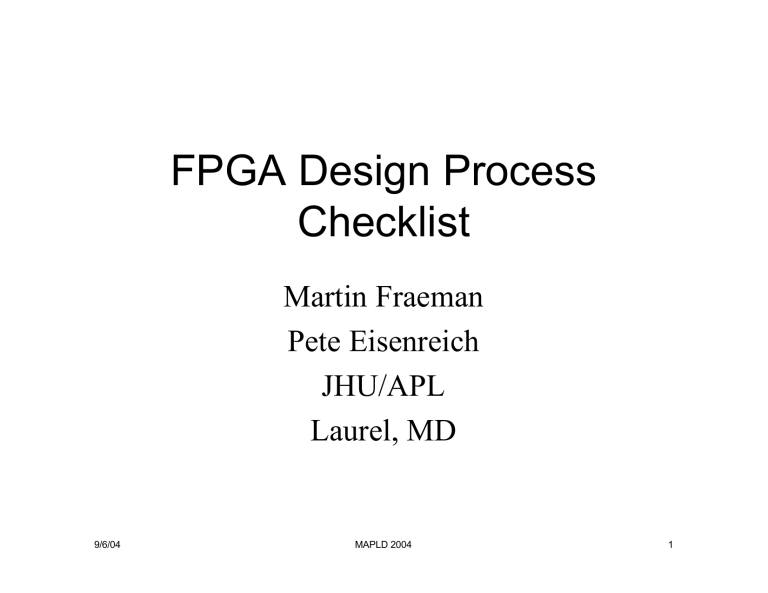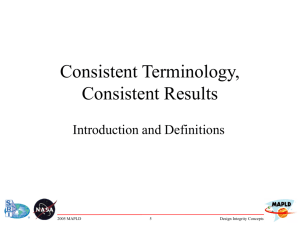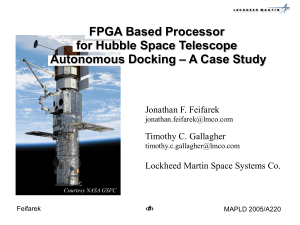fpga design checklist
advertisement

FPGA Design Process Checklist Martin Fraeman Pete Eisenreich JHU/APL Laurel, MD 9/6/04 MAPLD 2004 1 Checklist Motivation • Develop a process to consistently design FPGAs for space applications • Useful to wide range of staff – Guide/reminder for experienced FPGA developers – Transition aid for designers new to FPGA – Training aid for inexperienced staff • Evolved from experience developing several spacecraft • First upfront applications now in progress • May also be applied to ASIC design 9/6/04 MAPLD 2004 2 Checklist Goals • Minimum Requirements for Hi-Rel apps – – – – Minimally burdensome to small or quick programs Program may require more Team may require more You have the freedom to do more if necessary • Technology Independent – Design rules for Actel 1020 different than 54SX-S or Virtex II – Peer organizations Design Processes from mid 90's, ISO9000 • Based on Actel 1020, not updated in 8 years • Contain requirements that do not universally apply – Either schematic or HDL – Use technology dependent supplements when needed 9/6/04 MAPLD 2004 3 Development Flow 9/6/04 MAPLD 2004 4 Requirement Requirements • Requirements must be defined, vetted, and documented – Memo to file, requirements review, or conceptual design review presentation material – Intent is to write it down without adding additional development burden • Keep up to date and distribute • Firm “chip spec” is rare; FPGA spec developed concurrently so requirements are often a moving target 9/6/04 MAPLD 2004 5 Requirement Contents • Functions • Environment constraints – Radiation – What not how – Identify critical functions and effect of failure • Mitigation strategies for SEU, total dose – Thermal – Mission duration • Interface definitions – – – – – – Signal levels Timing Circuit def’ns Software Data formats Impact of failures • Testability provisions – Scan based test port – Board JTAG chain • Constraints imposed by target technology/tools – Target part • SSO impact on pinout • Timing methodology – CAD tool flow 9/6/04 MAPLD 2004 6 Requirements Review • Discuss FPGA req’ts with all concerned – Board, component, subsystem, system, and software engineers – Others with interfaces to the FPGA • Informal review, not a power point contest; Paper and sketches are OK • May be delayed until conceptual design completed or as part of board requirements review 9/6/04 • TBDs and Tentative Requirements are OK. State what’s understood and what still needs to be figured out • Understand why of req’ts to distinguish between firm, goal, desire, assumption • Reduce to minimum • Avoid over-performance, unneeded features • Keep up to date as design works out details MAPLD 2004 7 Conceptual Design • Consider alternate design approaches to satisfy the requirements • Outputs – Detailed block diagram – Functional block descriptions • May be appropriate to develop requirements and conceptual design together 9/6/04 MAPLD 2004 8 Conceptual Design Factors FPGA Related • Evaluate and select target technology – – – – Capacity, speed Environmental Board design impact Thoroughly understand app notes, alerts, warnings, especially for space applications • Functions needing special attention – SEU mitigation – SSO impact on pinout – High speed serial interfaces • Choose CAE tools • How implementations fit target FPGA architecture • IP availability, quality, suitability, prior designs, other reuse 9/6/04 MAPLD 2004 – – – – Capability Availability Productivity Teams expertise in tools and need for training 9 Conceptual Design Factors Project Related • KISS – Easier to get right – Easier to know its right – Easier to know its reliable • Breadboard things – To clarify vendor docs – Check performance – Verify requirement is feasible • Simulation/test approach to verify req’ts met • Can satisfying requirements still meet schedule? – Then one or the other MUST change! – Plan for that now or watch it happen anyway 9/6/04 MAPLD 2004 10 Detailed Design • Terminated after resolution of action items raised at Engineering Design Review (EDR) • EDR must be completed before programming flight parts • Frequently breadboard/engineering model will have been built and debugged • EDR is late in development so significant problems exposed are tough to fix • Requirement review should have caught those sorts of problems • Consider informal reviews during breadboard development 9/6/04 MAPLD 2004 11 Detailed Design Issues For EDR • Global net distribution • Edge sensitive races caused by routing • Decode noise, SEU impact on async inputs • Target tech SEU rates • SEU mitigation – Target tech SEU rates – Critical circuits (config reg, state reg) SEU rates and impact – Effect on combinational circuits like async reset – FSM invalid state response 9/6/04 • Other radiation effects • I/O impact on internal/board routing • I/O and SSO bounce • Programmed I/O modes (threshold, level, slew, termination, …) • I/O state impact on I/F during power on/off • Worst case simulation (process, temp, radiation) • External failure impact through I/O on FPGA MAPLD 2004 12 Detailed Design Good Design Practices • Modular design to ease testability and simulation • Use spare pins to increase observability during debug and test • Build test board to verify over temp, volt • Add test points to flight board to help debug and test • Make sure board test verifies FPGA functions 9/6/04 • Verify margins on critical signals • Avoid using probe/diagnostic pins for application signals • Do a static timing analysis in both worst and best case corners • Code coverage analysis of simulation and test vectors MAPLD 2004 13 Engineering Design Review Goals • Present updated requirements – Functional, program, and organization process – Use verification matrix to show how met • Must be readable by the uninitiated – Must include clear block diagrams – HDL must show as synthesized logic for critcal/interesting modules • Review board – Chair independent (not working on same board) – At least one member familiar with board/box • Publish: presentation, minutes, action items, responses 9/6/04 MAPLD 2004 14 Engineering Design Review Design Walkthrough • Detailed Design EDR issues • As synthesized gate level schematics for critical circuits with source code • How FSM illegal states are handled • Decode glitches/SEUs don’t effect asynchronous or edge sensitive circuits • Appropriate use of global clock signals • Asynchronous set/reset inputs are glitch free 9/6/04 • Power on reset and how sync’d with clocks • Resynchronization across clock boundries • SEU susceptibility or immunity where important • Other circuits of interest, particularly for SEU review • Worst/Best case simulations/timing analysis results concentrating on external interfaces MAPLD 2004 15 Formal Documentation • Organizational tracking number – Drawing number at APL • Store/Archive all design files under drawing number • “all design files” includes – – – – – 9/6/04 Hierarchy of files sufficient to reconstruct design Tool independent format such as text or pdf List of design tools and version # Tool dependent key files (fuse or memory map) Any other information deemed important by the designer MAPLD 2004 16 Other Documentation • Design review material (especially EDR) • Encouraged to also prepare – User guide – Documentation for module with potential for reuse 9/6/04 MAPLD 2004 17 Options to Consider • • • Future Revisions to FPGA Process Centralized flight parts programming Independently verify that flight version matches archived version Post-programming electrical test • Same review team follows the design thru several reviews? • Suggestions? – Controversial – consensus of users heading towards “no” – Some vendors strongly against 9/6/04 MAPLD 2004 18




